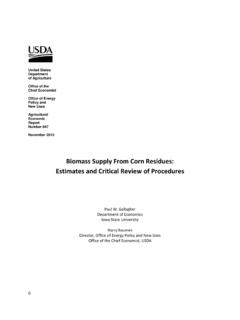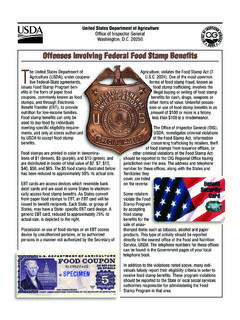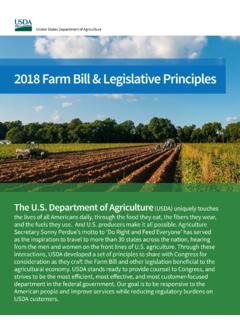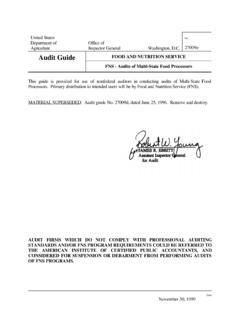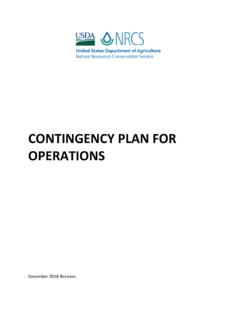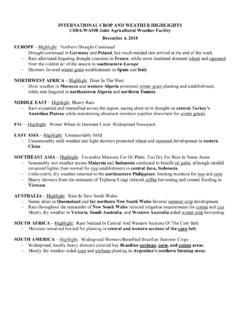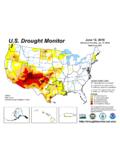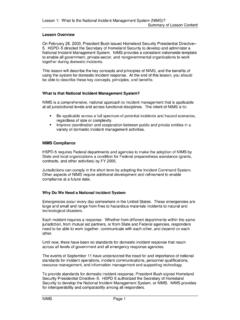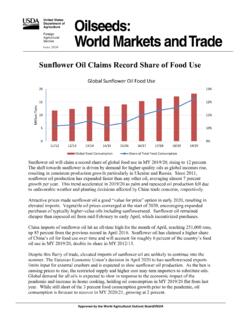Transcription of United States Department of Agriculture iiiiiiii
1 United States Department of Agriculture . urban . Agriculture . TOOL KIT.. urban . Agriculture . TOOL KIT. S. mall community gardens, urban farms that span several city blocks, and intensive indoor hydroponic or aquaculture facilities are all examples of urban Agriculture . This fast-growing phenomenon has the potential to nourish the health and social fabric of communities and create economic opportunities for farmers and neighborhoods. But it also comes with a unique set of challenges and opportunities. urban farmers, federal and city government agencies, and local organizations around the country have developed a variety of tools to help address those chal . lenges and assist the growth of Agriculture in cities. This toolkit makes these re . sources available to anyone interested in participating in urban farming. The toolkit lays out the common operational elements that most urban farmers must consider as they start up or grow their operations.
2 It also contains a special section on resources for developing indoor growing operations, such as aquaponic facilities. For each element, the toolkit identifies technical and financial resources that have been developed by federal, state, and local partners. While some of the elements require local-level solutions ( zoning), federal programs and services can support a variety of activities related to urban farming. Table of Contents 1 Starting an urban Farm: What Are the Costs? 2 usda urban Agriculture Toolkit Summary of Key Resources 6 Land Access Federal Funding for Accessing Land Community Educational Resources for Accessing Land 7 First Steps: Visiting the Farm Service Agency 8 Soil Quality Federal Educational Resources for Assessing and Managing Soil Quality Federal Funding for Soil Testing Community Educational Resources for Assessing Soil Quality 10 Water Federal Educational and Funding Resources for Water Community Educational Resources for Water 11 Accessing Capital and Financing Federal Educational Resources for Accessing Capital and Financing Federal Funding Resources for urban Farm Capital and Financing Community Educational Resources for Accessing Capital and Financing 12 Infrastructure Federal Funding Resources for urban Agriculture Infrastructure Community Educational Resources for urban Agriculture Infrastructure 14 Financing Infrastructure for Indoor Growing Environments 15 Production Strategies Federal Educational Resources to Support urban agricultural
3 Production Federal Technical Resources to Support urban agricultural Production Community Educational Resources for urban Agriculture Production 17 Applying for a Federal Grant 18 Market Development Federal Funding Resources to Support urban Agriculture Market Development Community Educational Resources for urban Agriculture Market Development 20 Training Federal and Mentoring Funding Resources to Support Training and Mentoring Community Resources for urban Agriculture Training and Mentoring 21 Safety and Security 22 Appendix A: General Guides for urban Agriculture 23 Appendix B: Cost Estimates for urban Farming Cost Estimates for urban Farming Location Site Preparation Structures Growing and Selling 24 Cost Estimate Table: Chicago 26 Cost Estimate Table: Indianapolis Starting an urban Farm: What Are the Costs? S Growing and Selling tart-up expenses for an urban farm will vary widely by location because many of the These are the expenses that you will expect to incur in components (such as land or utilities) are your first year of operation (as opposed to true start-up site-specific.)
4 Start-up expenses can be broken down costs, which may involve additional expenses). They into a few categories: include traditional farming costs such as tools, growing Location supplies and utilities, as well as business costs like This includes acquiring the land, making sure it is advertising and website design. zoned properly and that the necessary permits are Administrative Expenses and Operating Costs in place, and getting an environmental assessment These will be ongoing costs associated with your done. In many cases, land access and soil tests can operation, but they are critical to take into account in be subsidized. year one, when you will be getting systems in place. Site Preparation Costs for Indoor Growing Facilities The costs associat . Once the land is purchased or rented and all the nec ed with indoor growing facilities, including aquaculture urban .
5 Essary permits and tests are clear for it to operate as an and hydroponic facilities, will be very different from start . urban farm, the farmer will need to prepare the land for ing an outdoor farming operation in the city. They will growing. The largest associated cost (and likely largest also vary widely depending on the type of facility you cost of the entire operation) will be soil, but soil prices look to build. A large-scale aquaponic facility located in will vary by location and volume. Other costs include a warehouse-type building may be a multi-million-dollar investment; a small aquaponics system housed in a Agriculture . fencing, signage, and getting adequate water to the site. greenhouse could be built for a few thousand dollars, or Structures even less if you are able to use salvaged materials. TOOL KIT. This includes both infrastructure necessary for growing In Appendix B, you will find start-up budgets compiled (such as high tunnels) and storing (such as a cooler).
6 From several urban farms that together provide a reason . What types of structures will be needed will be depen . able average cost estimate for starting up in urban agri . dent on location, types of crops grown, and desired culture. Resources to finance the operation are outlined length of growing season. in the coming pages. URB. urban . AN AAGRICUL. GRICULTURE. TURE TTOOL. OOL KIT. KIT 11. usda urban Agriculture Toolkit: Summary of Key Resources 1 5 7. Business Planning: When you begin an urban Guide for Safe Gardening Practices provides step-by Capital and Financing: urban Agriculture projects Market Development: It's not enough to grow farm, you are also starting a business. The federal step recommendations on how to assess the risk of can have significant start-up costs that require ac your crop. You also have to let consumers in your Partnership for Sustainable Communities has de soil contamination, conduct soil sampling, and perform cess to loans, grants, and investments to get the area know you are selling it.
7 urban growers are de . veloped an urban Farm Business Plan Handbook that best management practices. Contact your local project off the ground. Having a sound business plan veloping creative strategies to reach nearby consumer helps you ask critical questions about your business Cooperative Extension office to learn about affordable can help show creditors that your operation is a worthy markets. usda 's agricultural marketing Service helps plans, operating strategies, and physical and human soil tests; many urban farmers test their soil through investment. The New Orleans Food and Farm Net farms connect with consumers through its Farmers resource needs. UMass Amherst's Soil and Plant Tissue Testing work's Farm Financing Reference Manual lists a wide Market and Local Food Promotion Program and Spe . 2. Laboratory, which provides one of the most affordable variety of funding sources once a plan is in place, and cialty Crop Block Grant Program.
8 usda Rural Devel . Land Access: Many farmers who operate in cities ways for individual farmers to test for toxins in their usda 's local FSA offices can offer credit to farmers for opment's Value-Added Producer Grants are available struggle to find and finance suitable land. Visit a soil. usda 's Natural Resources Conservation Service working capital or infrastructure development. for marketing research and development. Meanwhile, local usda Farm Service Agency office to in . 6. (NRCS) also provides soil survey resources including having your crops certified as organic can be an import . quire about FSA Farm Loan Programs that may be able Infrastructure: On-farm infrastructure from high the Web Soil Survey which provides soil data and ant selling point. The National Organic Certification to help you purchase land. urban farmers have also had tunnels to cold storage to on-farm solar energy includes specific soil interpretations for urban soils.
9 Cost-Share Program provides reimbursements for up success working with their city development agencies can be a key part of a successful operation. 4. to 75 percent of the costs of organic certification, up to and land trusts to identify vacant land to adopt or lease. Water Access/Use: Efficient water use will help NRCS offers help financing high tunnels and efficient a maximum of $750. To learn from other cities, visit the urban agricultural keep operating costs down and help you carefully irrigation through local NRCS offices. FSA can support Legal Resource Library's compilation of resources on manage this limited resource. While contacting cold storage through its Farm Storage Facility Loan Other helpful toolkits and guides with important land access for urban Agriculture . your city or local water authority may be your best avail program.
10 usda 's Sustainable Agriculture Research information for urban farmers: 3. able option for access to water, you can also contact and Education program (SARE) supports research and Soil Quality: In some urban settings, soil can Cornell University's Northeast Beginning Farmers your local usda Natural Resources Conservation education projects for on-farm sustainable energy and present unique challenges, including contamina Project Guide to urban Farming. Service (NRCS) office for both financial and technical season extension. And usda 's Rural Energy for Amer . tion. That makes it critical to test the quality and Baltimore City Farm Alliance's urban Agriculture assistance to help implement conservation practices, ica Program (REAP) is available to producers in both toxicity of the soil where you want to operate. There are How-to Guide. including water-use efficiency.
